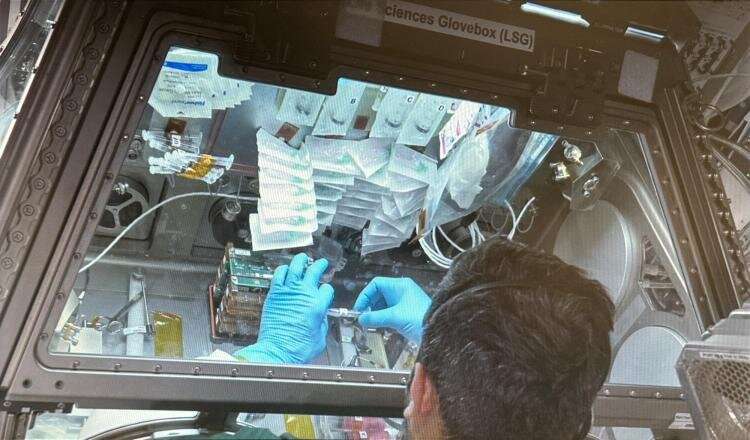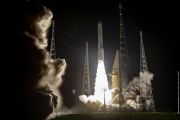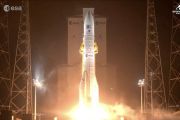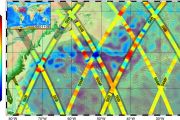
Copernical Team
NASA study helps explain limit-breaking ultra-luminous x-ray sources
 These objects are more than 100 times brighter than they should be. Observations by the agency's NuSTAR X-ray telescope support a possible solution to this puzzle.
Exotic cosmic objects known as ultra-luminous X-ray sources produce about 10 million times more energy than the Sun. They're so radiant, in fact, that they appear to surpass a physical boundary called the Eddington limit, which
These objects are more than 100 times brighter than they should be. Observations by the agency's NuSTAR X-ray telescope support a possible solution to this puzzle.
Exotic cosmic objects known as ultra-luminous X-ray sources produce about 10 million times more energy than the Sun. They're so radiant, in fact, that they appear to surpass a physical boundary called the Eddington limit, which Guiding JUICE to Jupiter
 This phenomenal endeavour, led by the European Space Agency, is powered by Airbus technology. Our engineers have rarely faced a greater challenge than enabling such a journey. The JUICE probe will encounter extreme temperatures, intense radiation and decreasing solar energy during its 5 billion kilometre journey. Being self-sufficient in energy generation and storage is key to the mission's succ
This phenomenal endeavour, led by the European Space Agency, is powered by Airbus technology. Our engineers have rarely faced a greater challenge than enabling such a journey. The JUICE probe will encounter extreme temperatures, intense radiation and decreasing solar energy during its 5 billion kilometre journey. Being self-sufficient in energy generation and storage is key to the mission's succ Heart experiments to help astronauts live better in space

Astronauts aboard the International Space Station are hard at work on research guided by students and researchers from the University of Colorado Boulder.
Two cardiovascular tissue experiments were launched to the ISS aboard SpaceX CRS-27 on March 15, 2023, and CU Boulder's BioServe Space Technologies developed the hardware for both. The research stems from National Institutes of Health grants led by Stanford University and Johns Hopkins University.
"When astronauts go to space it can have negative impact on their cardiovascular systems," said Stefanie Countryman, director of BioServe. "Our organs evolved to work here on Earth so they function differently in space. The goal with both of these projects is to better understand how these treatments impact cardiovascular issues in Earth bound people and to advance treatments that could be provided to astronauts before launch or while in space."
BioServe has been designing, building, and flying microgravity life science research experiments and hardware since 1987.
Scientists discover a way Earth's atmosphere cleans itself
 Human activities emit many kinds of pollutants into the air, and without a molecule called hydroxide (OH), many of these pollutants would keep aggregating in the atmosphere.
How OH itself forms in the atmosphere was viewed as a complete story, but in new research published in Proceedings of the National Academy of Sciences, a research team that includes Sergey Nizkorodov, a University of C
Human activities emit many kinds of pollutants into the air, and without a molecule called hydroxide (OH), many of these pollutants would keep aggregating in the atmosphere.
How OH itself forms in the atmosphere was viewed as a complete story, but in new research published in Proceedings of the National Academy of Sciences, a research team that includes Sergey Nizkorodov, a University of C Ice sheets can collapse faster than previously thought possible
 Ice sheets can retreat up to 600 metres a day during periods of climate warming, 20 times faster than the highest rate of retreat previously measured.
An international team of researchers, led by Dr Christine Batchelor of Newcastle University, UK, used high-resolution imagery of the seafloor to reveal just how quickly a former ice sheet that extended from Norway retreated at the end of the
Ice sheets can retreat up to 600 metres a day during periods of climate warming, 20 times faster than the highest rate of retreat previously measured.
An international team of researchers, led by Dr Christine Batchelor of Newcastle University, UK, used high-resolution imagery of the seafloor to reveal just how quickly a former ice sheet that extended from Norway retreated at the end of the An invisible underwater glacier loss in the Himalayas
 A new insightful study reveals that the mass loss of lake-terminating glaciers in the greater Himalaya has been significantly underestimated, due to the inability of satellites to see glacier changes occurring underwater, leading to critical implications for the region's future projection of glacier disappearance and water resources. The research, which combines multi-temporal satellite data wit
A new insightful study reveals that the mass loss of lake-terminating glaciers in the greater Himalaya has been significantly underestimated, due to the inability of satellites to see glacier changes occurring underwater, leading to critical implications for the region's future projection of glacier disappearance and water resources. The research, which combines multi-temporal satellite data wit The ice in Antarctica has melted before
 Sixty per cent of the world's fresh water is bound up in Antarctic ice sheets. Thirty million cubic kilometres of ice is perhaps a difficult number to grasp. But if absolutely all Antarctica's ice melted, the seas would rise by 58 metres on average.
"The ice sheet in East Antarctica stores enormous amounts of water. This means that this is the biggest possible source of future sea level ri
Sixty per cent of the world's fresh water is bound up in Antarctic ice sheets. Thirty million cubic kilometres of ice is perhaps a difficult number to grasp. But if absolutely all Antarctica's ice melted, the seas would rise by 58 metres on average.
"The ice sheet in East Antarctica stores enormous amounts of water. This means that this is the biggest possible source of future sea level ri Absolute zero in the quantum computer
 The absolute lowest temperature possible is -273.15 degrees Celsius. It is never possible to cool any object exactly to this temperature - one can only approach absolute zero. This is the third law of thermodynamics.
A research team at TU Wien (Vienna) has now investigated the question: How can this law be reconciled with the rules of quantum physics? They succeeded in developing a "quantu
The absolute lowest temperature possible is -273.15 degrees Celsius. It is never possible to cool any object exactly to this temperature - one can only approach absolute zero. This is the third law of thermodynamics.
A research team at TU Wien (Vienna) has now investigated the question: How can this law be reconciled with the rules of quantum physics? They succeeded in developing a "quantu A new type of photonic time crystal gives light a boost
 Researchers have developed a way to create photonic time crystals and shown that these bizarre, artificial materials amplify the light that shines on them. These findings, described in a paper in Science Advances, could lead to more efficient and robust wireless communications and significantly improved lasers.
Time crystals were first conceived by Nobel laureate Frank Wilczek in 2012. Mun
Researchers have developed a way to create photonic time crystals and shown that these bizarre, artificial materials amplify the light that shines on them. These findings, described in a paper in Science Advances, could lead to more efficient and robust wireless communications and significantly improved lasers.
Time crystals were first conceived by Nobel laureate Frank Wilczek in 2012. Mun Scientists use NASA satellite data to determine Belize coral reef risk
 Using two decades of NASA satellite measurements stored in the cloud, scientists recently assessed the vulnerability of Belize's renowned coral reefs to bleaching and collapse. The findings could help management authorities protect the reefs from human impacts such as development, overfishing, pollution, and climate change.
The 185-mile-long (298-kilometer-long) barrier reef system off the
Using two decades of NASA satellite measurements stored in the cloud, scientists recently assessed the vulnerability of Belize's renowned coral reefs to bleaching and collapse. The findings could help management authorities protect the reefs from human impacts such as development, overfishing, pollution, and climate change.
The 185-mile-long (298-kilometer-long) barrier reef system off the 






























